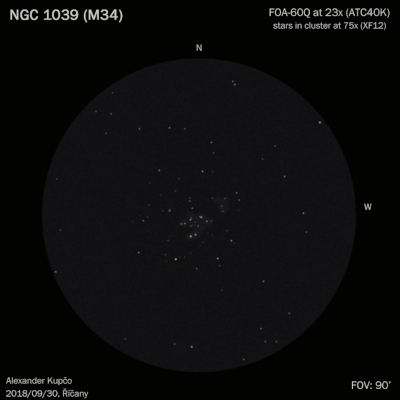
Giovanni Hodierna probably discovered M34 = NGC 1039 = h248 around 1654, though there is some doubt on his intended object. Charles Messier found M34 again on 25 Aug 1764, and is generally credited with the discovery. William Herschel described M34 on 17 Oct 1786 (sweep 614) as "a cl of scattered L stars, considerably rich." John Herschel called it a "fine cluster, about 20 st 9 10...11m and as many less. Fills field, coarsely scattered."
300/350mm - 13.1" (12/22/84): about 100 stars in a 30' diameter. Very bright, very large, many double stars, three main curved lanes. Includes a bright double star h1123 = 8.0/8.0 at 20". Naked-eye object in fairly dark sky.
600/800mm - 24" (12/28/13): gorgeous low power field with 21mm Ethos (125x; 49' diameter). The cluster roughly extends 35' with a much richer and brighter core of ~12'-15' that contains a large number of mag 8-10 stars. Several of the brighter stars appear as wide doubles or in chains. A long string of stars is on the south side of the core, extending towards the southeast. Other chains extend north and east out of the core. Several doubles were identified using the chart in Stoyan's "Atlas of the Messier Objects". O? 44 is a challenging mag 8.5/9.0 pair at 1.4" that just resolved at 225x and better at 300x. Another 8th mag star (C component) is widely separated at 86". h2154 is a 9.5/10.9 pair at 10" on the SW side and h1123 is a very wide 20" pair of mag 8.4 star. Also in the core is ES 1506, a challenging mag 8.9/14 pair at 7" and h2155, a very wide 8.3/10.3 pair at 17" on the NE side. PN Abell 4 lies 38' ESE of center.
Notes by Steve Gottlieb